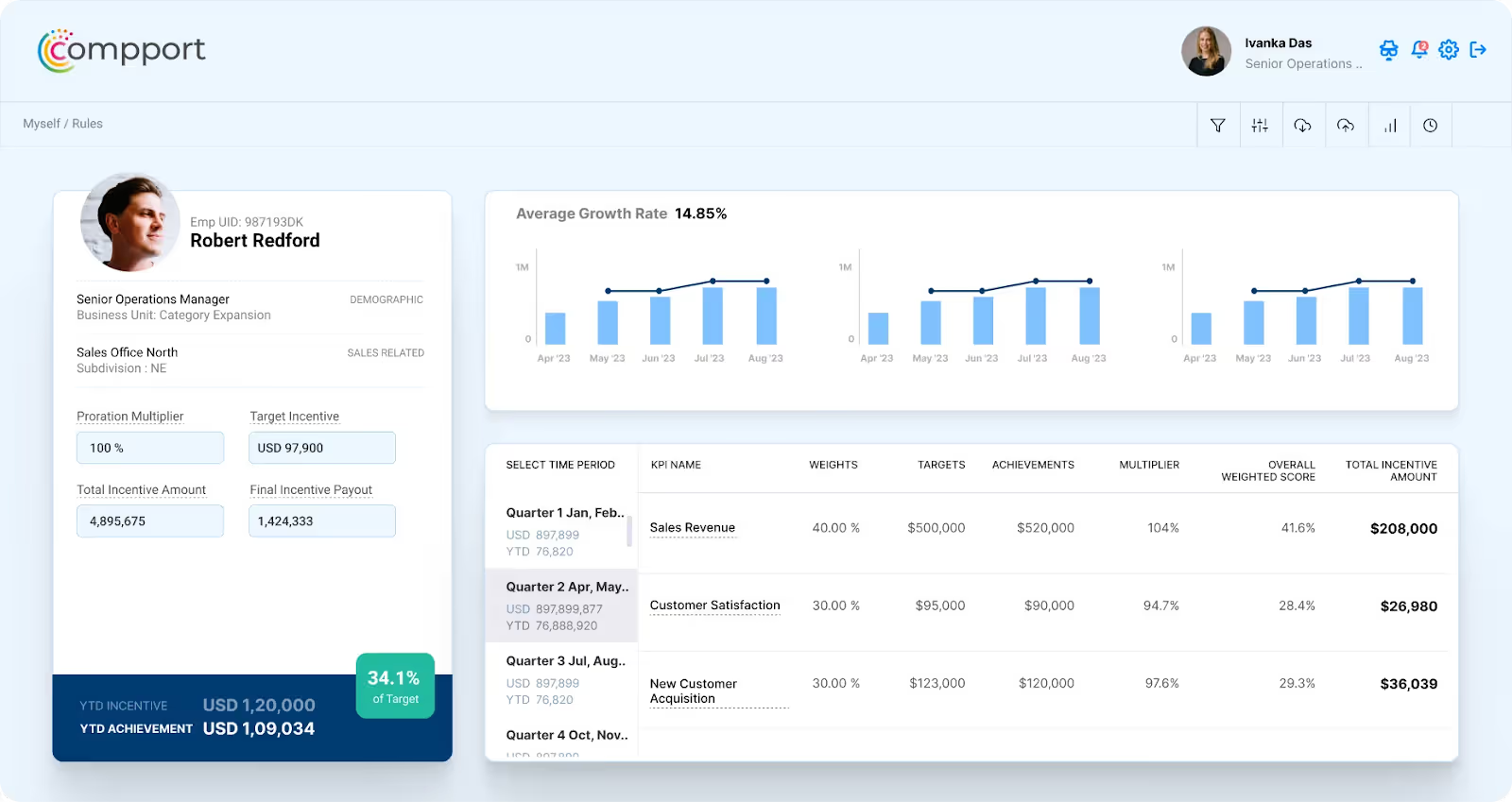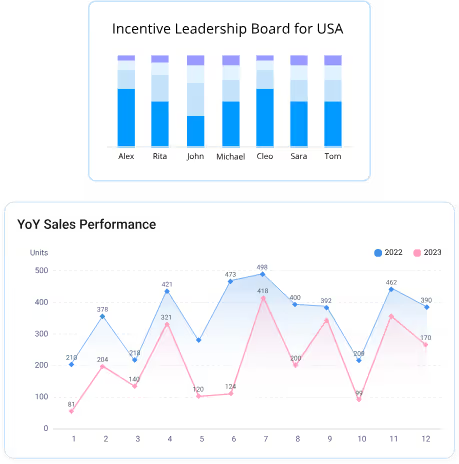5 Costly Mistakes in Sales Incentive Calculations (+Fixes)
%20(3).avif)
You're rewarding your sales team for hitting targets, yet you can sense that they are unhappy. Upon digging, you discover that your top performer earned less than someone who closed fewer deals.
Does this sound familiar?
Sales reps question payout calculations every month. And if you're spending hours in spreadsheets that crash when you need them most, it could mean losing your best sales reps!

Most sales incentive problems aren't about reward amounts but flawed calculation methods.
Whether you're a Sales Operations Manager, HRBP, or CRO, getting sales incentive calculations wrong costs you your best people. Organizations make critical mistakes, especially in large enterprises where exceeding targets is routine, because they still rely on broken spreadsheets.
But you can easily avoid these mistakes with the right approach. In this article, we'll show you exactly how to calculate sales incentives using proven formulas and avoid costly mistakes that break sales teams.
How to Calculate Sales Incentives?
Let us show you two different approaches to calculating sales incentives:
Approach one: Quota-based method
This method is simpler and focuses purely on the quota achievement percentage
Here are the standard steps and formula:
- Determine the monthly/quarterly sales quota
- Record the total sales made by your sales team as a whole
- Calculate the percentage of quota achieved based on the below sales incentive formula:
- Define a bonus rate for sales reps to pay when their quota is met. For example, if they get a $1000 sales quote, the bonus will be $800
- Now calculate the sales incentive based on performance
Following the above example, if a sales rep achieves 80% of their quota, their sales incentive will be [ $800*0.8 ] = $640. Similarly, if a sales rep exceeds their quota and achieves 120%, their incentive will be [ $800*1.2 ] = $960.
To understand the sales incentive calculation process in detail 👇
💡Read: The Step-By-Step Guide to Designing a Sales Incentive Plan
Approach two: Component-margin method
This method breaks down different components like direct commission, profit share, and performance incentives.
Step 1: Define your incentives
Your incentives can be based on direct commission (based on sales), profit sharing or equity (if you are a startup), performance incentives, and other non-cash incentives that you need to define clearly. Everything needs to be rounded to monetary costs for you.
For example, your incentive compensation can be $5000 in cash or $2000 in cash, a free retreat and an iPhone. The absolute number has to be defined regardless.
Where:
- Direct Commission = Base Commission Rate × Sale Value
- Profit Share = (Net Profit × Share Percentage)
- Performance Incentives = Milestone Bonuses + Achievement Bonuses
- Non-Cash Value = Monetary equivalent of benefits
Step 2: Create the compensation structure for your targets
We have already talked about targets in the previous section. You must make them measurable and transparent for your team to monitor and achieve.
For example, if a salesperson gets $X commission for turning a discovery call into an SQL, an additional $Y compensation for turning the SQL into a customer, and a further bonus of $Z for retaining the customer in the next term, it should be measurable.
Where:
- Discovery Call Incentive = Discovery Bonus ÷ Call Target - SQL
- Incentive = SQL Bonus ÷ SQL Target
- Closing Incentive = Closing Bonus ÷ Sales Target
- Retention Incentive = Retention Bonus ÷ Retention Target
Step 3: Calculate the incentives
To calculate sales incentives, start by estimating the cost of goods sold (COGS) for your business. Then, subtract any expenses related to selling the product or service—such as advertising and shipping—from the COGS to get what's left over after paying your costs.
Where:
- COGS = Direct Material + Direct Labor + Manufacturing
- Overhead Selling Expenses = Marketing + Sales Ops + Distribution + Other Direct Costs
Step 4: Divide by the revenue
Next, divide the remaining figure by your total revenue to assess how much profit each sale contributes. This calculation helps you gauge how much you can allocate toward sales incentives while maintaining profitability. Ultimately, these figures will guide you in setting effective compensation targets.
Where: Incentive Allocation Rate = 20% (typical baseline)
Step 5: Have automation to distribute and track Rewards
Compensation management software like Compport can help you calculate compensation, distribute rewards efficiently, notify your team when incentives are delivered, maintain records systematically, and visualize data effectively.

Mistakes to Avoid when Calculating Sales Incentive
Imagine you are promised a massive reward for fulfilling your sales targets. You and your team work day and night to make that happen, but in the end, you get only a certificate as your sales incentive.

Sounds unreal? A Reddit user shared a similar experience in this thread.
That brings us to the sales incentive mistakes. While there can be different types of mistakes, here are a few common mistakes that can break your sales team’s heart:
Mistake #1: Not taking into account tax implications
When calculating your sales incentives. This means despite getting a good bonus, the financial gains of the sales reps will be less as they will need to pay taxes.
Mistake #2: Not opting for a reliable sales incentive planning tool
Not opting for a sales incentive planning software to back up, re-check, and verify all the payouts can hurt your organization badly.
Real Example: One sales professional discovered that finance had incorrectly removed their commission split from a $14 million account 18 months earlier, costing them $50- 80k in back pay.(Source)
Sales teams need sales incentive planning tools like Compport. It incentivizes metrics that matter, establishes transparency for sales leads, and helps them identify and act on business priorities.
Compport’s sales incentive dashboard typically looks like this:

Admins and sales team leads can perform the following actions on this platform:
- Set up incentive schemes and build plans with built-in formula builder
- Build custom approval workflows and collect inputs from relevant stakeholders
- Provides visibility into your team’s performance so you can make informed decisions on whether or not you want to change the plan
- Offers insights into all incentive KPIs
The tool is equally helpful for sales reps. They can keep a tab on their performance in real time and predict potential earnings with less room for confusion.
Mistake #3: Not factoring everything during calculations
You have to factor in key aspects during your calculations. For example, let’s say sales rep A closes five deals with a high customer satisfaction rate and good scope of retention, while sales rep B closes five deals, out of which 3 are bad deals at risk of churn. Sharing the same reward with both reps could foster a culture where deals are closed to achieve a sales target.
Not thinking through different aspects of an incentive plan can result in inaccurate earnings projections, increased churn and employee turnover, incorrect payouts, and poor financial health. Implement different aspects of incentivization discussed in this guide that align with your overall business to avoid these problems.
Mistake #4: Misrepresenting commissions to your team
Do not mislead your salespeople with false promises or hidden terms and conditions. This can have a profound negative impact on employee morale, regardless of any legal implications.
When trust is compromised, employees may look for opportunities elsewhere, leading to higher turnover rates and decreased productivity. This impacts individual performance and fosters a toxic work environment for everyone involved.
Real example: A top-performing sales rep discovered their company had posted incorrect quota numbers on their commission sheet.
"I was 1% away from the next commission payout in reality, but the reference sheet was wrong. Had I known this, I easily could have worked more and made that extra 1% of sales required for a pay bump." (Source)
Other mistakes include:
- Not having a streamlined process to collect sales data from ERP and CRM leads to incomplete sales data. This would mean errors in calculating sales bonuses
- Having only annual sales incentive programs and ignoring the monthly and quarterly efforts of your team
- Offering only one-dimensional incentives like cash or non-cash rewards. Not diversifying sales incentives can mean demotivating the sales reps as there is scope for expectation mismatch
💡Download our Pay Equity Guide E-book to develop an unbiased, fair sales incentive plan.
What’s Next?
Organizations often struggle with keeping their sales reps motivated and engaged due to mismanaged sales incentive programs. From calculation errors to delayed payouts, these challenges can lead to frustrated sales teams and potential talent loss.
A well-structured sales incentive plan isn't just about rewards—it's about creating a transparent system that fairly compensates performance. This guide breaks down the essential formulas, planning strategies, and common pitfalls in sales incentive calculation.
With solutions like Compport, organizations can automate these calculations, ensure accuracy, and maintain transparency in their incentive programs. Compport is the sales incentive planning tool of choice by organizations across 37 countries.
Here’s why you should consider exploring Compport:

- Manage multiple incentive schemes across roles, teams, and geographies — each with its own KPIs, rules, and payout logic
- Empower sales teams with a mobile app to track performance and simulate potential earnings as they go
- Handle multi-currency KPIs and conversions effortlessly — perfect for global sales teams
- Upload and cascade department-wise targets across hierarchies, ensuring full alignment and clarity
- Auto-generate incentive letters with complete change logs, payout history, and API-based data sync
Here’s what our clients say about us:
Want to see Compport in action?

FAQs
What are Sales Incentives?
Sales incentives are rewards given to sales reps in addition to their base compensation to encourage productivity, improve performance, and motivate them to meet or exceed their targets.
While a sales compensation model focuses on monetary rewards for closing deals, sales incentive programs take a more comprehensive approach. They aim to boost morale, build a collaborative work environment, and foster long-term engagement through monetary and non-monetary rewards.
How to calculate the incentive amount?
Calculate the incentive amount using the formula: Sales incentive = Base bonus * (Actual Sales/Sales quota). First, determine the quota and bonus rate, then apply the performance-based formula.
What is the incentive percentage?
Incentive percentage is the portion of total compensation tied to performance, calculated as: (Actual sales/sales quota) * 100. It shows the percentage of the target quota a sales rep achieved.
What are the problems with incentives?
Common problems include unclear calculation methods, tax implications, delayed payments, unfair distribution, and over-reliance on single reward types. Poor incentive planning can lead to employee dissatisfaction and turnover.
What is the formula for calculating sales incentives?
There are two main formulas: 1) Quota-Based: Sales incentive = Base bonus × (Actual Sales/Sales quota) 2) Component-Margin: Total Incentive = Direct Commission + Profit Share + Performance Incentives + Non-Cash Value.
What is a sales incentive in salary?
Sales incentives are additional rewards beyond base salary given to sales reps to boost productivity and motivation. These can include commissions, bonuses, profit sharing, and non-cash benefits like retreats or devices.
What are the types of sales incentives?
There are three broad sales incentive programs: Performance-based, Cash-based, and Commission-based.
1. Performance-based sales incentive programs pay employees based on their performance (for example: if a salesperson hits their quota).
2. Cash-based sales incentive programs pay employees based on the amount of money they bring in (for example: if a salesperson brings in $50,000 in revenue).
3. Commission-based sales incentive programs pay employees a certain percentage of the sales they make (for example: if a sales representative sells a product worth $5000 she gets a straightforward commission of 10%).
What is incentive compensation, and how is it different from other forms of compensation?
Incentive compensation is a system where employees are rewarded for achieving specific goals or working hard. It differs from other forms of compensation like time based or hourly pay because it's based on outcomes or revenue earned by employees.
Why do sales incentives matter, and how do they benefit businesses?
Sales incentives matter because they motivate sales teams, align individual and company goals, boost productivity, enhance employee retention, and foster healthy competition. They can also improve customer satisfaction and drive revenue growth.


%20(49).png)
%20(48).png)
%20(47).avif)
